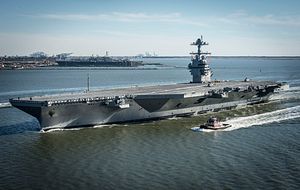U.S. defense contractor Raytheon and the U.S. Navy have conducted the first-ever live fire test of the USS Gerald R. Ford’s (CVN 78) so-called Ship Self Defense System (SSDS) Integrated Combat System on the U.S. Navy’s Self Defense Ship, Raytheon said in a February 5 press statement.
During the test, the SSDS Integrated Combat System, installed aboard the Self Defense Ship—a remotely controlled refurbished Spruance-class destroyer designed to test the self defense systems of surface combatants—successfully engaged an unmanned aerial vehicle target off the coast of California.
The SSDS Integrated Combat System processed the cooperative engagement capability (CEC) data, determined the appropriate engagement ranges, passed launch commands to the missile and scheduled dual band radar support for the engagement, according to Raytheon.
“The design of our Ship Self Defense System enabled seamless integration of the sensors and missiles with the CVN 78 combat system during this first-of-its-kind test, proving the ability of the system to defend our sailors,” said Mike Fabel, Raytheon’s SSDS program manager. “This integrated combat system success brings Ford [herself] one step closer to operational testing and deployment.”
The U.S. Navy plans to conduct further developmental and operational testing of the Ford’s integrated combat system in 2019.
The USS Gerald R. Ford is currently undergoing its year-long post-shakedown availability (PSA) period at Newport News Shipbuilding in Newport News, Virginia. PSA, which addresses technical deficiencies found after the successful completion of sea trials, began in July 2018 and is set to be completed in July 2019. PSA also includes final integration of the USS Gerald R. Ford combat systems.
The Ford hosts numerous untried new technologies including advanced weapons elevators, main turbine generators, a new dual-band radar system, a new advanced arresting gear on the flight deck, as well as the new electromagnetic aircraft launch system. These new technologies, among other things, were principally responsible for the aircraft carrier’s delayed commissioning and induction, as well as contributed to the growing overall costs of the carrier program.
“CVN 78 began construction with immature technologies and an incomplete design, leading to cost and schedule growth,” the U.S. Government Accountability Office noted in an April 2018 report. “The ship delivered 20 months later than the Navy planned, with construction-related work still remaining and over 40 serious deficiencies that could impact ship operation or safety.” Total cost for the lead ship of the class are estimated at almost $13 billion.
The various deficiencies are now being addressed during the PSA phase. “The problems that we know about, we’ve got solutions to those problems,” Admiral John Richardson, Chief of Naval Operations, was quoted as saying by the Navy Times during a visit to the USS Gerald R. Ford this month. “We’re just installing those solutions and moving forward.”
Following completion of the PSA phase, the carrier will undergo shock trials, which includes detonating underwater charges in close proximity to the carrier to test the warship’s key systems under combat conditions. The carrier’s first operational deployment is currently slated for 2022.































